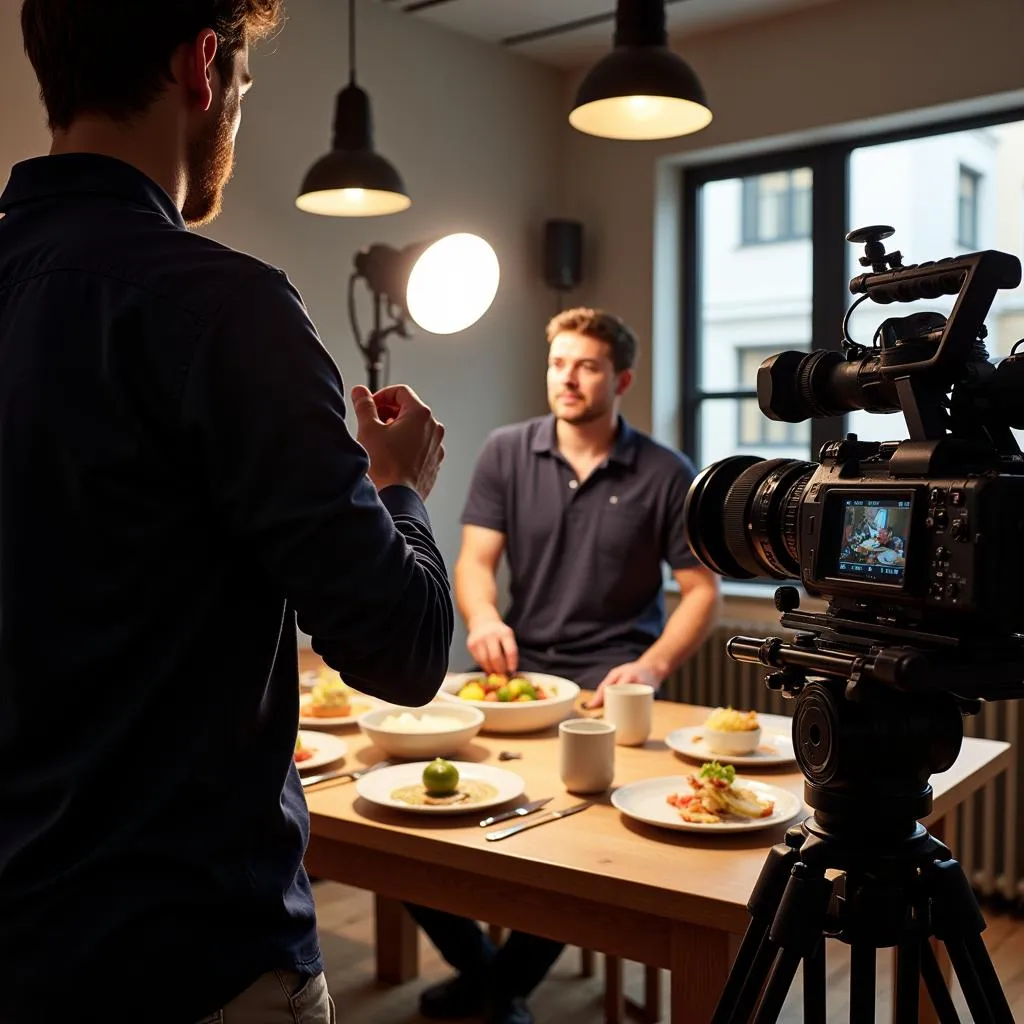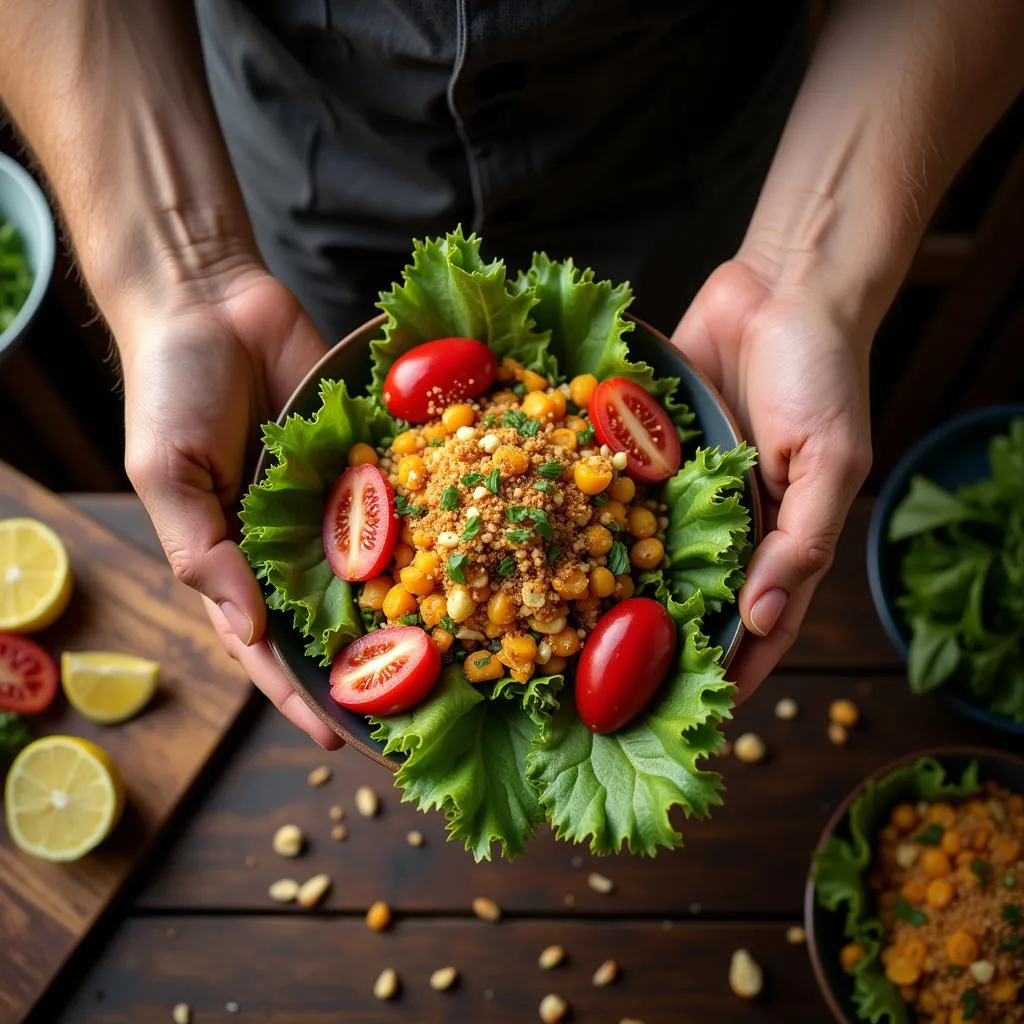Food Video Production. It’s the art of transforming culinary creations into visual feasts, making mouths water through the screen. Whether you’re a restaurant owner wanting to showcase your signature dish or a food blogger sharing your latest recipe, high-quality food video production can take your content to the next level. But where do you begin? This guide will walk you through everything you need to know, from pre-production planning to post-production polish.
 Professional Food Video Production Setup
Professional Food Video Production Setup
Planning Your Culinary Close-Up: Pre-Production Essentials
Just like a perfectly prepped ingredient, successful food video production starts with thorough planning. This ensures a smooth and efficient shoot, so you can focus on capturing those mouthwatering shots.
1. Define Your Recipe for Success: Setting Goals and Objectives
Before you even think about cameras and lights, take a moment to define your goals. What message do you want to convey with your video? Are you aiming to boost brand awareness, drive sales, or simply share your passion for food?
2. Know Your Audience: Serving Up the Right Content
Understanding your target audience is crucial. Are you targeting seasoned foodies or home cooks looking for inspiration? Knowing your audience will guide your video’s style, tone, and content.
3. Crafting a Story: Adding Flavor to Your Visuals
Even a simple recipe video needs a compelling narrative. Think about the story you want to tell and how you can engage viewers from the first frame.
4. Budget Wisely: Getting the Most Out of Your Ingredients
Establish a realistic budget for your food video production. This includes costs for equipment, crew (if necessary), props, location, and post-production.
Setting the Stage: Food Video Production Equipment and Setup
The right equipment and setup can make or break your food video. Here’s a breakdown of the essentials:
1. Camera: Your Window to Culinary Delights
While professional-grade cameras offer exceptional quality, don’t underestimate the power of a good DSLR or mirrorless camera.
2. Lighting: Showcasing Food in the Best Light
Good lighting is crucial for making your food look appetizing. Natural light is ideal, but investing in artificial lighting equipment, such as softboxes or LED panels, provides greater control.
3. Sound: Capturing Every Sizzle and Crunch
Don’t neglect the importance of audio. Use a quality microphone to capture the sounds of cooking and the final product. Crisp, clear audio enhances the sensory experience.
 Overhead Camera Angle for Food Videography
Overhead Camera Angle for Food Videography
Action! Filming Tips for Mouthwatering Results
Now that your set is ready, it’s time to start filming! These tips will help you capture stunning food shots that leave viewers craving more.
1. Composition: Arranging Your Culinary Masterpiece
Experiment with different angles and compositions to create visually appealing shots. The rule of thirds, leading lines, and negative space can all enhance your visuals.
2. Movement: Adding Life to Your Food Story
Don’t be afraid to incorporate movement into your shots. A slow pan across a beautifully plated dish or a close-up zoom into a sizzling steak can captivate viewers.
3. Variety: Keeping Things Interesting
Mix up your shots to keep viewers engaged. Use a combination of wide shots to establish the scene, medium shots to showcase the cooking process, and close-ups to highlight details.
The Finishing Touches: Post-Production for Polished Perfection
Post-production is where your food video truly comes together.
1. Editing: Creating a Seamless Culinary Journey
Edit your footage to create a cohesive and engaging narrative. Trim unnecessary footage, add transitions, and use music and sound effects to enhance the mood.
2. Color Correction and Grading: Enhancing Visual Appeal
Color correction and grading ensure your food looks as appetizing on screen as it does in real life.
3. Music and Sound Design: Creating a Sensory Experience
The right music and sound effects can elevate your food video, adding to the overall sensory experience. Choose music that complements the mood and pace of your video.
Frequently Asked Questions
1. What is the average cost of food video production?
The cost of food video production varies widely depending on factors such as video length, complexity, location, equipment, and crew.
2. Do I need professional equipment for food video production?
While professional equipment delivers superior results, you can achieve impressive results with a good DSLR or mirrorless camera, basic lighting, and a quality microphone.
3. How long does it take to produce a food video?
The production timeline depends on the video’s complexity and length. A short recipe video might take a few days, while a longer, more elaborate production could take weeks or even months.
 Editing Food Videos on Computer
Editing Food Videos on Computer
Ready to Create Food Videos That Pop?
Food video production is an art that blends culinary expertise with visual storytelling. By following these tips and tricks, you’ll be well on your way to creating mouthwatering content that captivates your audience. Need help bringing your culinary vision to life? Contact Mina Cones Food at Phone Number: 02437655121, Email: minacones@gmail.com Or visit us at: 3PGH+8R9, ĐT70A, thôn Trung, Bắc Từ Liêm, Hà Nội, Việt Nam. Our dedicated team is available 24/7 to assist you.